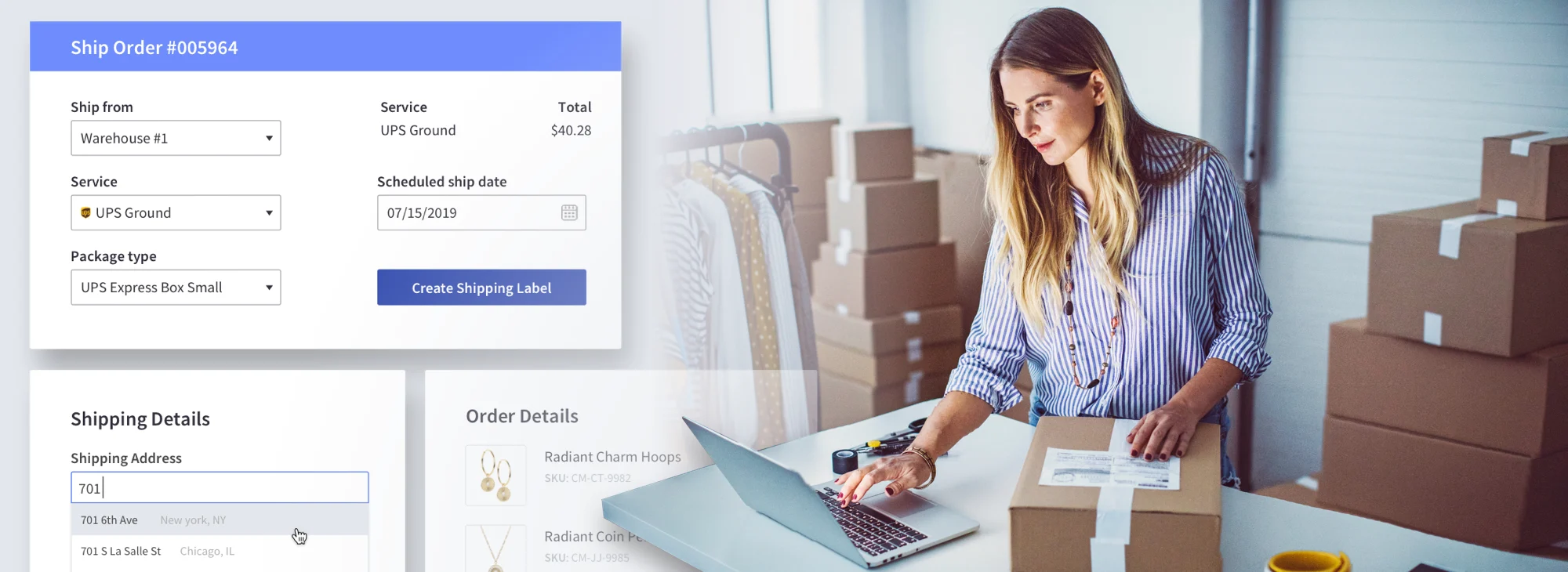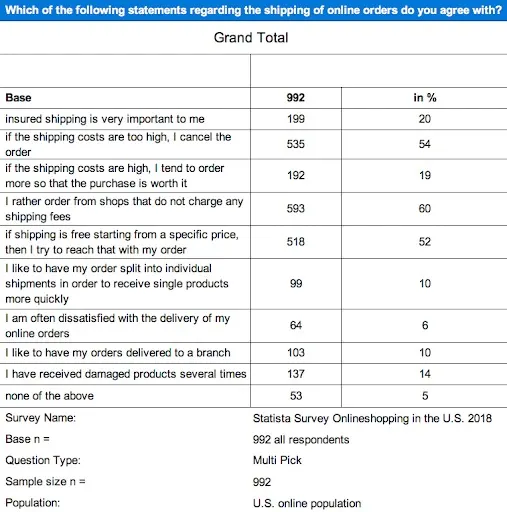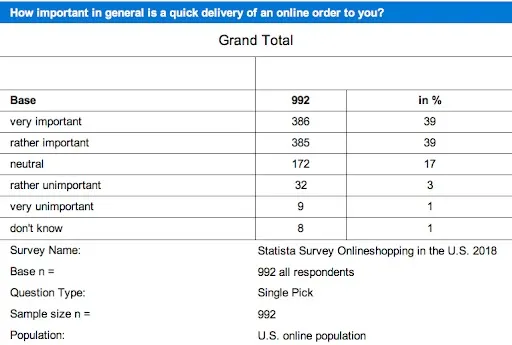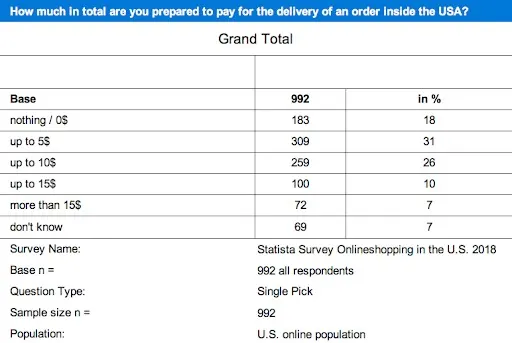Finding The Best Shipping Software For Your Business (Provider Comparison + Guide)


Finding The Best Shipping Software For Your Business (Provider Comparison + Guide)
Get The Print Version
Tired of scrolling? Download a PDF version for easier offline reading and sharing with coworkers.
A link to download the PDF will arrive in your inbox shortly.
The ecommerce industry’s main differentiator from the technology industry is in physical fulfillment. Once you capture cash, you have to then fulfill your shipping and delivery promises.
The entire post-purchase experience, including how you ship, is an extension of your brand.
Putting your customer first in the post-purchase chain and competing with the likes of Amazon and Walmart is not easy.
Amazon, for instance, has 2-day and even 2-hour shipping, as well as convenient pick-up options to a nearby locker. Walmart allows you to buy online and pick up in store –– as does Home Depot and a plethora of others.
What can a non-Fortune 500 retailer do to keep up?
Implement a shipping platform that will help your business meet your shoppers’ shipping and fulfillment needs, without taking a hit to your profit margin.
These shipping software and technology companies are doing their part to help mid-market and small business retailers around the world streamline their shipping processes and compete more effectively with the standards and expectations set by retail giants like Amazon and Walmart.
So, whether you are looking for multi-warehouse solutions that enable 2-day shipping anywhere in the U.S., the lowest possible shipping rates and in-cart options for consumers at checkout, or back-office shipping streamlining with bulk printing and configurable shipping rules, these shipping software solutions have your back.
Shipping Trends and Customer Expectations
Before we dive into your shipping software options, let’s take a quick look at the current shipping expectations landscape to know what you are up against.
Here are a few key data points to think through.
1. 60% of consumers prefer to shop on sites that offer free shipping.
This stat from 2018, suggests that free shipping is not just a marketing ploy.
Free shipping is a true expectation among customers. And, if you aren’t doing it, your competitors likely are.
54% of consumers will cancel an order if shipping costs are too high, contributing to your overall abandoned cart rate. Seriously, imagine being *this* close to closing the deal, and your shipping cost boots the consumer out of the checkout. Not ideal.
52% of shoppers will buy more if they see an order amount threshold to receive free shipping. Be creative with your promotions, and use the lure of “free shipping” to increase your average order value. That way, it makes logical sense for the business to offer free shipping, without taking as much of a hit to your profit margin.

2. 78% of consumers state that a quick delivery method is important.
Not only do your shoppers expect increasingly cheaper shipping options, they also want those options to be fast. Shoppers are now expecting their products to be delivered in less than a week.

3. 75% of consumers won’t pay more than $10 for shipping.
If you still want to charge for shipping, just know that most shoppers won’t spend more than $10 on shipping costs and over half of those shoppers won’t pay more than $5.

Executive Summary
Ecommerce businesses of all sizes have to deal with shipping and fulfillment in some manner.
We understand that each business is unique in how they fulfill their products.
There seems to be a limitless amount of shipping and fulfillment management software in the market today, how do you pick the right one?
We have shipping recommendations for needs as simple as “I just need to print my USPS labels” to “I am a high volume, global business and need to get my items to customers across the world”.
What type of shipping software is right for my business?
When choosing a shipping software it is important to focus on what needs around shipping and fulfillment you are looking to solve.
Below are the categories that most shipping software fall into.
1. In-cart rating / checkout.
When your shopper is checking out, it is important that you offer them the best options to close the sale.
As noted above, having competitive shipping options is critical to conversion.
Many merchants still only charge a flat rate for shipping or offer a free (but slow) shipping option. Shoppers want choice.
Every shopper has different expectations around delivery that depend primarily on what they are shopping for and when they need their order.
For example, if a shopper is buying a last minute gift for a party, they will want the option to overnight the gift or pay for express delivery. If you only have a free but slow shipping option, you may see a lot of abandoned shopping carts.
You might be asking these questions:
Should I create flat rates based on expedited, free and standard shipping?
How would I even know the best rates to charge?
Will this negatively impact my profit margin?
There are in-cart rating tools for each business need.
At the most basic level, you can connect to the API of a single carrier to display live rates at checkout.
Even better, you can take advantage of a multi-carrier shipping software like EasyShip, who already has negotiated rates with multiple carriers to display live rates at checkout, giving your shoppers even more options.
If you really want to hone in on this experience, use a software like ShipperHQ, which allows you to not only connect to almost any carrier but also customize the shipping options you show shoppers through advanced rules.
An example of this would be if you are selling perishables, you need to have them delivered to your customers within a specific timeframe. In ShipperHQ, you can set the option shown as “Express” and automatically display an overnight shipping option when the customer selects that perishable item.
Ok great, now I have all of my in-cart rates in place that are specified to the needs of my business, now what?
2. Label printing.
Once an order comes in, you have to find some way to get it to your customer’s doorstep. There are many ways to do this, but the most popular is through a label printing solution.
Many merchants today are still relying on a basic copy and paste method of printing labels.
That means, for every order that comes into the dashboard, merchants copy those order details and then have another window open with their specific carrier’s shipping manager, and paste the customer’s shipping details to then print a label.
Seems tedious, right?
This is why shipping software like ShipStation, ShippingEasy, and many more came to market.
These label printing softwares allow merchants to connect their store to not just one but multiple carriers so that when an order comes in, all the right details get transferred directly into one easy to use shipping dashboard to print labels.
Not only are the days of copy and pasting on their way out, but merchants now can speed up their shipping process even more by bulk printing their labels.
Imagine that, clicking “select all orders” and then clicking “print shipping labels” and then right away, all the appropriate labels and shipping documentation are generated for those orders.
Another perk that a label printing solution can offer merchants is the ability to leverage some amazing shipping rate discounts.
Top label printing solutions all partner with one or many carriers and can leverage their volume of customers to negotiate really low rates.
One prime example is ShipStation. Through ShipStation, merchants can get significant discounts with multiple carriers such as UPS, USPS, FedEx, DHL, and more.
These discounts would be unheard of for small and medium-sized businesses trying to negotiate on their own.
Merchants are no longer just selling in their stores. Many will go to marketplaces like Amazon, eBay, Jet and others. Order management and order fulfillment can get really complicated when selling through multiple sales channels.
Imagine having 2 ecommerce stores, and selling on 4 marketplaces. That means 6 different places to check for orders and print packing slips and shipping labels.
This is a major challenge facing merchants and it is only increasing as the popularity of marketplaces grow.
This is why most retailers will rely on a label printing solution that has multi-channel fulfillment capabilities such as ShipStation. With ShipStation, merchants can connect all of their channels, including stores and marketplaces, into a single dashboard to print and manage their shipments.
Every marketplace has its own rules that merchants have to abide by. Many of these rules revolve around fulfillment expectations.
ShipStation helps merchants navigate these complexities by allowing you to set up rules based on which marketplace the order is coming from, so that when an order comes from Amazon, it will automatically get a non-branded shipping label, as an example.
After the shipping label is generated, the journey does not end there.
3. Tracking and returns.
Shoppers want to know where their package is at all times.
It makes sense, as they paid for it and already believe the product is in their ownership.
How do merchants keep their shoppers satisfied with the post-purchase experience?
The best way to keep customers happy post-purchase is to give them real-time updates of where their order is and when it is expected to be delivered. Merchants handle this in many ways.
The simple way to handle tracking is through the label printing software.
Most label printing software will either send the tracking information back into the ecommerce platform that will then trigger an email with the tracking details to the customer.
The customer can then click on the link to go to the carrier’s website and use their provided tracking numbers to see the location of the order or to subscribe to more detailed email or SMS updates.
Another way to handle tracking is through a branded tracking page.
Shipping software like ShipStation will not only send an email to notify the customer that the order was shipped, but will also send them a tracking link that takes the customer to a tracking page that is branded to match the merchant’s website.
There are many benefits to having this feature. First, it gives the customer the confidence that the merchant is still in control of the delivery process, and that the merchant will have the customer’s back if something is to happen.
Second, it encourages the customer to go back to the merchant’s site where they will be encouraged to purchase again.
Some merchants want to give the top of the line tracking experience to their customers automatically, without the shopper ever having to click through to the carrier’s site to then subscribe to detailed delivery notifications.
Tracking software like AfterShip allows merchants to delight their customers with updates at every step of the journey: from shipped, to out for delivery, to delivered. This gives customers the peace of mind in knowing their package is secured and on time for delivery, without having to call into your support team.
Every business would love to not have to ever deal with returns, but in this day and age, it is nearly impossible.
There are many cases that cause shoppers to return their order such as: the order not containing the right items, an item being damaged, or just the shopper being unsatisfied with the product for one reason or another.
Many shoppers will not even buy from merchants if they do not have a return policy.
So how do you go about offering the best return experience to your customers, without having to take on too much of the burden of customer support managing these return requests?
There are great return solutions in the market. Many are actually built in to the ecommerce platform or can be found in a label printing software such as ShipStation and EasyShip. The trend is to offer customers a fully self-serve return experience.

Software like Aftership can be plugged into the ecommerce store so that when a shopper is returning a purchase, all they have to do is type in their order number and email, and then their order details will pop up.
From this, they can choose the items they would like to return and select the reason why. They can also choose if they want a full refund or if they would like store credit.
This is a great option for merchants as they do not lose as much margin. Once the shopper has selected the return reason and credit option, they just print the return label from their computer and drop the package off at the post office. It’s that easy.
4. Cross-border shipping.
Many merchants find shipping and fulfillment tedious to deal with in their own country. Imagine that challenge being expanded to the rest of the world.
Merchants selling cross-border have the added complexity of customs amongst many other things.
Customs can be daunting.
Merchants are expected to know exactly what their product is classified as, the HS code, have some system in place to calculate the duties for that particular item, and then make sure that it gets to the customer without them having to pay any unexpected fees, due to the duty calculation being incorrect.
This is where cross-border solutions like EasyShip come in to play.
Merchants can use EasyShip to calculate taxes and duties and print all the necessary customs documentation, so that the order can go through customs quickly and painlessly.
Even better, if the duty calculation happened to be incorrect, EasyShip will pay the difference when the order is in customs, so that neither the merchant nor the shopper ever have to see a difference.
In order for merchants to step up cross-border another notch, EasyShip partners with local couriers, so that when an international shopper buys from your site, the package will be delivered to them by the courier they know and trust.
For businesses that really want to take cross-border to the next level, they might choose a full localization and parcel forwarding solution like Webinterpret.
This allows merchants to have their website localized to 60 different countries — meaning the language, currency and even the shipping options are all fully localized. They even take care of getting the package overseas and to the customer, so you only have to handle getting it to them.
5. 3PL / warehousing.
If you are planning to expand rapidly, have orders that just seem to be piling up, or would rather not focus your time on fulfillment, leveraging a 3PL is a great option.
A 3PL, or third party logistics company, can help manage the supply chain, deal with the hassle of warehousing and fulfillment, and for many businesses, be a more affordable solution for expansion.
Many businesses consider this option as they are expanding outside of shipping from their house or garage. At this time, you have to consider if you want to take on the costs of owning your own warehouse, hiring warehouse staff, or investing in a warehouse management solution (WMS) — and that’s just the beginning.
A 3PL like ShipBob has conveniently located distribution centers across the United States. They also have full-time staff that are experts in fulfillment, and a process that holds their staff to high standards.
What does this mean for your customers?
As noted earlier, the demands for quick delivery have been increasing and Amazon has made 2-day delivery the new standard. Most 2-day delivery options would be either just downright unattainable or too expensive, the shopper would never pay and the merchant can’t just eat the cost.
That is where utilizing a 3PL solution like ShipBob becomes important.
As soon as an order comes through your site, it will automatically be routed to ShipBob, which will take into consideration the inventory levels of your products and the customer’s location.
They will then choose the appropriate warehouse and get the order packaged, label printed, and parcel shipped so that the shopper gets their order in the time they were expecting it, without delay.
6. Dropshipping.
If you partner with vendors and either dropship some or all of your catalog, a dropshipping solution might be the right fit.
Dropshipping can be a confusing term, as it seems everyone interprets it differently.
For simplicity, it can be broken down into two main areas: “I fulfill most of my products but partner with a vendor to supply other items that compliment my product catalog” and “I don’t fulfill any of my own orders and just manage the storefront, then I send the orders to my suppliers to fulfill”.
For merchants that fulfill many of their own products but also supplement their catalog with products from a supplier, a label printing solution like ShipStation might be the best fit.
ShipStation is a great option for these merchants, as it allows you to print labels from one dashboard, but also to assign certain SKUs to a specific supplier. You can then give a special log-in to that supplier that is restricted, so they only see the orders that they need to fulfill.
For merchants that do not fulfill any of their own products, using a software like ShipperHQ would be a great solution. This is because with ShipperHQ, you can define all of the vendor locations and assign products to specific vendors. That way, when a shopper goes to checkout, the shipping cost and delivery time will be accurate.
For more advanced order routing, merchants should depend on an ERP or OMS to complement their in-cart rating solution.
Best Shipping Software for 2020
Now that we have covered the main categories of shipping software, let’s focus on which would be the best solution for your business.
Below is a list of the best shipping software for each specific category and business need. It is important to note that these solutions are not created equal, meaning that where some are more broad in scope, others are hyper focused on just one area of shipping and fulfillment.
Successful merchants with complex shipping and fulfillment needs tend to couple solutions to meet their particular business needs.
An example of this would be using ShipperHQ for advanced in-cart rating, ShipStation for label printing, and Aftership for tracking and returns.
The options are limitless, so really focus on exactly what needs you have and what solutions are the best to solve those.
1. Multi-Channel Label Printing and Dropshipping.
Business need: “I sell on marketplaces and/or have multiple stores and need a way to consolidate my orders to print shipping labels.”
ShipStation
ShipStation’s motto is “Wherever you sell, however you ship,” and they really own this audience.
No matter the channels you sell on, ShipStation has an integration. That means, all orders will flow into just one dashboard to manage. If you dropship or partner with a 3PL for fulfillment, ShipStation has the option for a dropship portal or can route orders to a 3PL.
Beyond that, ShipStation is incredibly intuitive, so you can get up and running quickly and efficiently. You can even manage label printing from your cell phone, it is that simple.
2. Advanced In-Cart Rating.
Business need: “I have specific requirements around shipping my products and need to have full control of the shipping options that are displayed to shoppers.”
ShipperHQ
There is a reason why ShipperHQ is ranked as the world’s #1 storefront shipping management system. Within ShipperHQ, the in-cart rating customizations seem limitless.
If you have a product that can not be shipped to certain areas due to restrictions, ShipperHQ has you covered.
If you want to offer free shipping but need to limit the products that are eligible, ShipperHQ can handle that.
If you have multiple warehouses and brick and mortar locations, and need to calculate the shipping options based on your locations and the shopper’s location, ShipperHQ has the logic.
So, if you have complex shipping requirements, and need to make sure your checkout reflects those, ShipperHQ is the best solution for you. An important call out is that while ShipperHQ is the best in the business for in-cart rating, if you also require a solution for printing labels, it can be coupled with a label printing solution of your choice.
3. Advanced Tracking and Returns.
Business need: “I want the best possible post-purchase experience for my shoppers.”
AfterShip
To offer a best-in-class tracking and returns experience for your shoppers, AfterShip is the solution for you.
AfterShip integrates directly to your control panel, so that every time you have fulfilled an order, the shipment information will be pulled into the system and alert the customer.
Where other solutions fall short in only alerting the customer when “your order was received” and “your order has been shipped,” AfterShip will alert them at every step of the transit journey.
That way, your shoppers know exactly where their product is, at all times — especially at the crucial moments of when the product is “expected to be delivered” and “out for delivery”.
The customer journey does not end once they get the package. AfterShip also handles the return request, so if a customer is unsatisfied, they can easily go to a returns portal to request a return, print the return label and get the package back to you.
So if you’re tired of your customers calling in daily to ask where their package is or wanting to return an item, choose AfterShip to automate this process.
4. Warehousing and Fulfillment.
Business need: “I want to offer 2-day delivery to shoppers without taking on the cost or hassle of warehousing and fulfillment.”
ShipBob
ShipBob is the best modern Third Party Logistics (3PL) solution for growing brands.
They can offer incredibly fast — meaning 2 days or less — shipping options to your customers across the United States. ShipBob deals with the complexities that go along with logistics such as managing the inventory levels of your products across multiple fulfillment locations.
They have the systems in place to account for which products are performing well in which geographies, also where most of your shoppers are located, and making sure there are enough items in the fulfillment center closest to those shoppers.
If personalization matters to your business, ShipBob has partners that you can utilize to create custom packaging, ensuring your shoppers have a social media photo-worthy “unboxing experience”.
So, if you are growing rapidly and need assistance from a powerful logistics provider, you can count on ShipBob.
5. Website localization and Parcel-Forwarding.
Ideal business: “I have a lot of international traffic, and want to make sure that my site is fully localized to all the markets I service.”
WebInterpret
When it comes to internalization, WebInterpret is the easiest solution to plug in to your existent store and quickly make it available to over 60 countries.
If you are seeing heavy international traffic but just not getting the sales volume you’d like in cross-border commerce, utilize WebInterpret’s localization expertise.
WebInterpret has a full localization service including currency conversion, language translation, size conversion, and shipping.
When an international order comes in, you just ship it to WebInterpret and they will handle getting the order across the border and to the shopper.
If you need the full localization experience for your international shoppers, but don’t want the hassle of managing cross-border shipping and fulfillment, WebInterpret is the solution for you.
6. Cross-border Label Printing and In-Cart Rating.
Ideal business: “I am expanding internationally and need a shipping software to handle duties as well as connect with global carriers to generate rates and print shipping labels.”
EasyShip
EasyShip has your business covered when it comes to cross-border shipping. They have partnered with global carriers to offer discounted shipping rates and offer fulfillment services. That means, when your international shopper gets their order, it will be coming from a courier they know and trust.
EasyShip also has you covered when it comes to displaying the fully landed costs at checkout to your shoppers.
Neither you nor you shoppers will run into any added costs after the order has been placed. Once the order comes in, you can choose the carrier and service that fits best, print the shipping label as well as customs forms and send the order on its way.
If you are expanding internationally and want to manage your own fulfillment, EasyShip is the best cross-border shipping solution for your business.
4 Experts Share Their Tips on Shipping Software
“Shipping software is a must-have if you are shipping over around 50 parcels per day. Find shipping software that ideally has a native integration with your platforms and ideally find one that handles both your shipping rules and integration with your chosen carriers for simplicity.” — Jason Greenwood, eCommerce Manager, HealthPost
“As you’re picking out an ecommerce shipping software, be sure to compare several solutions, ask a lot of questions, and consider scenarios such as growth/scaling, pricing, customizability, pick/pack/ship options, customer service and support options, etc.” — Corey Dubeau, VP Marketing, Northern Commerce
“When you first start out, don’t worry too much about automating your shipping software — this comes later, once you have proved your concept and know that your business has the potential to grow. Once you’re at the next step, it’s time to automate your ecommerce store with your chosen shipping providers. There are plenty of off-the-shelf integrations available that will do this for you with no manual input.” — Katie Keith, Co-Founder, Barn2 WordPress Plugins
“Your shipping software is an updating and changing platform just like BigCommerce is. Watch out for that and keep it up to date. A lot of people call in a panic because of a shipping problem that tracks back to not being aware of a change to the plugin they’re using.” — Joe Chilson, Head Writer and Project Manager – 1Digital Agency
Conclusion
If you are just opening up your first online store, switching ecommerce platforms or just looking for ways to optimize your online business, use these steps to choose the best shipping software:
Sit down and think through your shipping process and fulfillment strategy.
List out what it is you want to offer your shoppers in terms of shipping options and shipping rates, and reconcile that with the resources you have on hand to manage shipping and fulfillment.
Review the list to see if there are any gaps between what you want to offer shoppers and what resources you have.
Use this to inform which shipping solution or solutions you choose.
At BigCommerce, we want to make sure that all merchants have the options they need to run a successful online business. That is why we have partnered with the best in the ecommerce shipping and fulfillment space.
If you have a shipping and fulfillment need that you can’t seem to find the right solution for, don’t hesitate to reach out. We will work with you to find the best fit solution.

Halie Adams is an Associate Product Marketing Manager at BigCommerce, where she strives to understand and advocate for what merchants need to run a successful online business. She has spoken to thousands of merchants, from aspirational businesses to established enterprises and has collaborated with agencies, tech partners and internal resources to make sure that merchants understand their options and can feel successful in opening and operating an online store.


